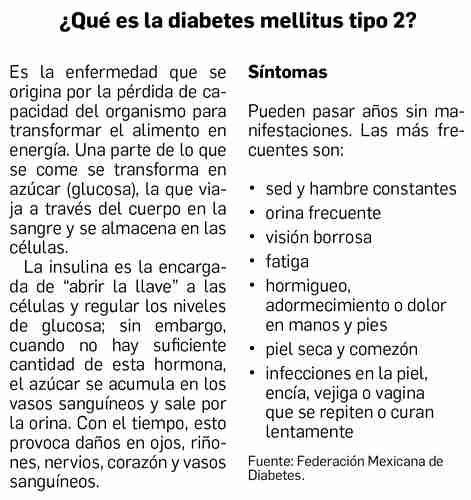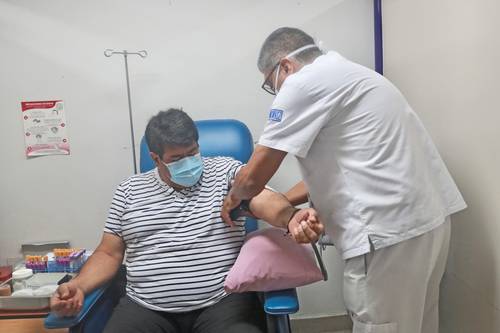14 million Mexicans suffer from type 2 diabetes; in two decades it could be double
▲ Taking samples from a patient at the INCMNSZ Comprehensive Care Center for Patients with Diabetes.Photo Luis Castillo

angeles cruz martinez
Newspaper La Jornada
Monday, November 14, 2022, p. 13
Mexico ranks seventh worldwide for the number of people with type 2 diabetes mellitus. There are around 14 million patients and in the next two decades the number could double, including serious complications that already cause the greatest number of years that those affected experience with disability. It is a problem that continues to grow and if this trend continues it could collapse any health system
warned Sergio Hernández Jiménez, coordinator of the Comprehensive Care Center for Diabetes Patients (Caipadi) of the Salvador Zubirán National Institute of Medical Sciences and Nutrition (INCMNSZ).
Type 2 diabetes mellitus is associated with overweight and obesity, a condition with which more than 70 percent of adults in the country live. It is also the second leading cause of premature death. Due to the covid-19 pandemic, there was a 50 percent increase in deaths, which went from 104,352 in 2019 to 151,019 in 2020, and last year there were 140,729 deaths, according to the National Institute of Statistics and Geography (Inegi).
In November 2016, this serious problem led the Ministry of Health (Ssa) to declare it an epidemiological emergency. Three years earlier, Caipadi was created, with a novel proposal to address the condition.
In an interview on the occasion of World Diabetes Day, which is commemorated today, Hernández Jiménez explained that the center applies a comprehensive care model, which has already shown that, with the strengthening of educational and prevention activities, it is possible to reduce complications, mainly renal failure, amputations and blindness that cause disability and high economic costs for the institutions and the families of the patients.
Uncontrolled diabetes also increases the risk of cardiovascular disease and death. It is best to never develop the metabolic disorder, but when you already have it, There is always something to do
to prevent complications. In some cases, they can be reversed or at least slowed down.
The basis is in the control of glucose levels, which in Caipadi is achieved by 60 percent of the patients. The same goes for blood pressure and cholesterol, which are also maintained at adequate levels in 70 and 60 percent of people, respectively. At the national level, these control indicators do not exceed 40 percent and their lack of control affects the development of collateral damage.
Hernández Jiménez highlighted that so far in 2022, there have been no reports of amputations due to diabetic foot in the center, an effect of the model that is applied and includes the revision of the feet and the training of patients on the daily care that they must have to prevent injuries that eventually lead to the loss of the limb.
The scheme consists of going beyond the prescription of medicines and offering consultations in nine specialties: endocrinology, diabetes education, ophthalmology, nutrition, psychology, dentistry, foot care, physical activity and psychiatry. All in one day. Patients return every month until completing four sessions, after which follow-up is annual.
This is how the center works with around 3,500 patients, some of whom have remained constant for nine years, although another similar number stopped attending the center. The Caipadi coordinator explained that various factors influence desertion, such as people’s change of address and the difficulties they face when absent from work. Even so, medical personnel have alternatives, such as telemedicine, developed during the covid-19 pandemic and which they resort to to maintain continuity of care for 5 percent of users.
The challenge is immense, despite the fact that, according to the specialist, the importance of comprehensive care has permeated the country and there are already other centers like Caipadi. He also commented that 40 percent of the patients who arrive for the first time have less than a year of diagnosis of diabetes and it has been revealing that a third of them already have certain alterations in the sensation of the feet (diabetic neuropathy), 15 per One hundred arrive with initial retinal lesions and a similar percentage report some degree of kidney damage.
This phenomenon also occurs on a global scale and is explained because, when the diagnosis of metabolic alteration is made, It is not that it appeared suddenly. It does not give for a scare or courage. It is a disease that develops over five to 10 years before symptoms appear.
explained Hernández Jiménez.
He stressed that although there are several risk factors, the main cause of diabetes is overweight and obesity. Some research reports mention that from this stage the first signs of involvement appear in other organs.
Another element that affects the high prevalence of diabetes is that the Mexican population has a high genetic predisposition, to which is added excess body weight.
Given this, the Caipadi adopted the criteria of asking patients to attend their consultations with the closest relative, with whom they live the most, so that clinical studies and reviews are also carried out. It was found that of the companions who did not present any symptoms, 11 percent already had diabetes and were unaware of it.
complications
Chronic renal failure is one of the main complications of diabetes and its progression can be prevented or, at least, delayed if, through a general urine test, creatinine levels are identified, which reveal whether there is kidney damage.
In Caipadi, the test is performed on all patients, but among people admitted to hospitals for a problem related to their diabetes, 23 percent have never had the test.
This is revealed by the Ssa’s quarterly report on hospital epidemiological surveillance of type 2 diabetes mellitus, which contains information provided by 163 hospitals in the country, where until last September 24,754 patient admissions were registered. Of the total, 84 percent said that they do not perform physical activity for at least 30 minutes a day, 38 percent had never had their feet checked, 65 percent had never seen an ophthalmologist, and 62 percent had not consulted an ophthalmologist either. nutritionist.
The data provided by the health surveys and the Ssa reports have served to undertake changes in the care model.
In addition to the general urine test, check-ups of the feet, eyes, teeth and, above all, the clinical analysis of glycosylated hemoglobin, which evaluates the average glucose levels in the last three months and is an instrument to determine if the sugar Is under control. It is also required to maintain adequate levels of cholesterol and blood pressure.
















